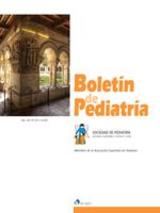Cribado neonatal de drepanocitosis en Castilla y León: Estudio descriptivo
J.M. Marco Sánchez , M. Sánchez Magdaleno , A. González Prieto , S. Riesco Riesco , M.C. Mendoza Sánchez , R. Herraiz Cristóbal , R. Portugal Rodríguez , J.M. Moreno Vidán , A.C. Muñoz Moreno
Bol. Pediatr. 2021; 61 (257): 160 - 165
Introducción. La anemia falciforme es una enfermedad de herencia autosómica recesiva que constituye una de las alteraciones genéticas más frecuentes del noroeste de Europa. Las complicaciones secundarias en los pacientes homocigotos son frecuentes durante los primeros 3 años de vida, y debido a ello, desde el 12 de julio de 2017, se ha incluido dicha patología dentro de las enfermedades objetivo de cribado neonatal de Castilla y León (CyL). Con tal fin, se pretende detectar aquellos pacientes que se beneficiarán de un diagnóstico y tratamiento precoz. Objetivos. Calcular la incidencia de hemoglobinopatía S, C, D, E u otra cadena de hemoglobina anómala en todo recién nacido vivo en CyL desde el inicio del programa de cribado hasta el 12 deoctubre de 2018 (15 meses), determinando en los distintos pacientes el sexo, lugar de origen del padre y la madre, hospital de nacimiento y fenotipo encontrado. Material y métodos. Estudio retrospectivo y descriptivo de los pacientes con cribado neonatal de hemoglobinopatías patológico nacidos en la Comunidad Autónoma de Castilla y León, del 12 de julio de 2017 al 12 de octubre de 2018. La muestra de sangre se obtuvo de la prueba del talón realizada en las maternidades de forma sistemática, a partir de las 48 horas de vida del niño. Se analizó por cromatografía líquida de alta resolución (Bio-Rad VARIANTnbs System) en Laboratorio de Referencia de Valladolid, detectándose fenotipos S, C, D, E o asociados a cualquier otra cadena de hemoglobina anómala sin tipificar. Resultados. Se incluyeron en el estudio 18.998 recién nacidos durante ese periodo, con un total de 18.975 muestras analizadas (99,8%). Se detectaron un total de 94 muestras positivas, con 1 resultado coincidente con fenotipo FS (1/18.975), 61 para fenotipo FAS (1/311), 14 FAC (1/1.355), 2 FAD (1/9.487), 1 FC (1/18.975), 11 FAX (1/1.725), y 4 FAXX (1/4.743). Del total de niños, no se realizó cribado en 23 recién nacidos, debido a fallecimiento en las primeras horas o traslado antes de las 48 horas de vida. En la gran mayoría de los casos, al menos uno de los padres fue de procedencia extranjera. Conclusiones. El diagnóstico precoz de drepanocitosis permite disminuir la morbi-mortalidad de los pacientes, por lo que es importante que sea incluido en el programa de cribado neonatal. Por el momento, se está realizando un adecuado seguimiento de los pacientes.
Neonatal screening of drepanocytosis in Castilla y Leon (Spain): a descriptive study
Introduction. Sickle cell disease is an autosomal recessive hereditary disease that constitutes one of the most frequent genetic alterations in the Northeast of Europe. The second ary complications in the homozygous patients are frequent during the first three years of life, and due to it, this condition has been included within the diseases targeted for neonatal screening of Castilla y Leon (CyL) since 12 July 2017. With that in mind, it is aimed to detect those patients who would benefit from and early diagnosis and treatment. Objectives. To calculate the incidence of hemoglobin diseases S, C, D, E or other abnormal hemoglobin chain, in all live newborn in CyL from the onset of the screening program until 12 October 2018 (15 months), determining gender, place of origin of the father and mother, hospital where born and phenotype found in the different patients. Material and methods. A retrospective and descriptive study of the patients with neonatal screening for pathological hemoglobin disease in the Regional Community of Castilla y León, from 17 July 2017 to 12 October 2018. The blood sample was obtained from the heel test conducted in the maternity wards systematically, beginning at 48 hours of life of the child. It was analyzed during rapid resolution liquid chromatography (Bio-Rad VARIANTnbs System) in the Reference laboratory of Valladolid, detecting the S, C, D, E or phenotypes or those associated to any other non-typified abnormal hemoglobin chain. Results. A total of 18,998 newborns were enrolled in the study during this period, with a total of 18,975 samples analyzed (99.8%). A total of 94 positive samples were detected, with 1 result coinciding with FS phenotype (1/18,975), 61 for FAS phenotype (1/311), 14 FAC (1/1,355), 2 FAD (1/9,487), 1 FC (1/18,975), 11 FAX (1/1,725), and 4 FAXX (1/4,743). No screening was conducted in 23 newborns out of all the children, due to death in the first hours or transfer prior to 48 hours of life. In most of the cases, at least on of the parents were or foreign origin. Conclusions. The early diagnosis of drepanocytosis makes it possible to decrease the morbidity-mortality of the patients, so that it is important for this to be included in the neonatal screening program. At present, adequate follow-up of the patients is being performed.
Artículo completo (PDF) (170 kb.)
- Neonatología
Buscar en el boletín
Año 2021, Volumen 61, Número 257

Boletín completo en PDF (847 kb.)